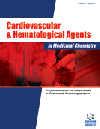- Home
- A-Z Publications
- Cardiovascular & Hematological Agents in Medicinal Chemistry (Formerly Current Medicinal Chemistry - Cardiovascular & Hematological Agents)
- Previous Issues
- Volume 4, Issue 2, 2006
Cardiovascular & Hematological Agents in Medicinal Chemistry (Formerly Current Medicinal Chemistry - Cardiovascular & Hematological Agents) - Volume 4, Issue 2, 2006
Volume 4, Issue 2, 2006
-
-
Platelet Signaling Induced by Lipoproteins
More LessAuthors: S. J.A. Korporaal and J. W.N. AkkermanCardiovascular disease is the main cause of death and disability in the Western society. Lipoproteins play an important role in the development of this disease and affect different cell types involved in atherosclerosis and thrombosis. Based on their density, five classes of lipoproteins have been identified which all influence cells via distinct mechanisms. Modification turns lipoproteins into atherogenic particles with a prominent rol Read More
-
-
-
Pathophysiology of Platelet Resistance to Anti-Aggregating Agents in Insulin Resistance and Type 2 Diabetes: Implications for Anti-Aggregating Therapy
More LessAuthors: Giovanni Anfossi and Mariella TrovatiThe insulin resistance syndrome, which presents among its many facets obesity and type 2 diabetes mellitus, is a major risk factor for cardiovascular events. Thus, therapeutic guidelines recommend multifactorial treatment programs including, especially in the presence of type 2 diabetes, antiplatelet drugs. Few data, however, are available about the protective effect of antiplatelet therapy in both obese and type Read More
-
-
-
Aldosterone Receptor Antagonists and Cardiovascular Disease: Do We Need a Change of the Guard?
More LessAuthors: Coty W. Jewell, Linley E. Watson, Jonathan Mock and David E. DostalAldosterone is a mineralocorticoid primarily produced in the zona glomerulosa of the adrenal gland. For many years, aldosterone (Aldo) was thought to have its sole site of action in the kidney, where it regulated sodium excretion and potassium reabsorption. It is now known that Aldo is produced in cardiovascular tissues, and has been implicated in the development of ventricular hypertrophy and cardiac fibrosis. The pre Read More
-
-
-
COX-Inhibiting Nitric Oxide Donors (CINODs): Potential Benefits on Cardiovascular and Renal Function
More LessAuthors: Marcelo N. Muscara and John L. WallaceThe COX-inhibiting nitric oxide donors (CINODs) are a new class of agents designed for the treatment of pain and inflammation. CINODs have a multi-pathway mechanism of action that involves COX inhibition and nitric oxide donation. The anti-inflammatory and analgesic effects of COX inhibition are reinforced through inhibition of caspase-1 regulated cytokine production, while nitric oxide donation provides multiorgan p Read More
-
-
-
Inflammation in Cardiovascular Disease and Regulation of the Actin Cytoskeleton in Inflammatory Cells: The Actin Cytoskeleton as a Target
More LessAuthors: T. H. Thomas and A. AdvaniCardiovascular disease is prevalent in developed countries causing very large burdens to health services. The underlying pathology is atheromatous plaque in the sub-endothelial region of the vascular wall. High levels of low density lipoprotein cholesterol and high blood pressure cause endothelial damage. Atheroma develop from a response to this injury that is perpetuated to chronic inflammation. The invasion of inflammatory leu Read More
-
-
-
The Role of Thrombomodulin in Atherosclerosis: From Bench to Bedside
More LessAuthors: Yi-Heng Li, Guey-Yueh Shi and Hua-Lin WuAtherosclerosis remains a leading cause of morbidity and mortality worldwide. In addition to the deposition of cholesterol in the arterial wall, inflammation, cell proliferation and migration play important roles in the pathogenesis of atherosclerosis. Thrombomodulin (TM) is a cell surface-expressed glycoprotein which is predominantly synthesized by vascular endothelial cells and a critical cofactor for thrombin-mediated a Read More
-
Volumes & issues
-
Volume 23 (2025)
-
Volume 22 (2024)
-
Volume 21 (2023)
-
Volume 20 (2022)
-
Volume 19 (2021)
-
Volume 18 (2020)
-
Volume 2 (2020)
-
Volume 17 (2019)
-
Volume 16 (2018)
-
Volume 15 (2017)
-
Volume 14 (2016)
-
Volume 13 (2015)
-
Volume 12 (2014)
-
Volume 11 (2013)
-
Volume 10 (2012)
-
Volume 9 (2011)
-
Volume 8 (2010)
-
Volume 7 (2009)
-
Volume 6 (2008)
-
Volume 5 (2007)
-
Volume 4 (2006)
Most Read This Month
Article
content/journals/chamc
Journal
10
5
false
en


